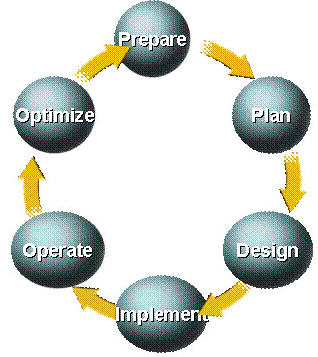PPDIOO Methodology
Cisco has formalized a network’s life cycle into six phases: Prepare, Plan, Design, Implement, Operate, and
Optimize. These phases are collectively known as PPDIOO.
Question 1
At which stage in the PPDIOO process would you analyze a customer’s
network in order to discover opportunities for network improvement?A. Plan
B. Prepare
C. Design
D. Implement
E. Operate
F. Design Assessment
Answer: C
Explanation
Design phase: Developing a detailed design is
essential to reducing risk, delays, and the total cost of network
deployments. A design aligned with business goals and technical
requirements can improve network performance while supporting high availability, reliability, security, and scalability.
Question 2
Which of these is the next step after the design phase in the PPDIOO process?A. Order the equipment.
B. Develop a high-level migration plan.
C. Create a pilot or a prototype network.
D. Develop the implementation plan in as much detail as possible.
E. Identify which network management protocol will be used for which function.
Answer: D
Explanation
The Implement phase begins after the design phase has been finished.
In this phase, new devices are installed, configured and tested
according to the design specifications.
Question 3
According to Cisco, which four improvements are the main benefits of
the PPDIOO lifecycle approach to network design? (Choose four)A. faster ROI
B. improved business agility
C. increased network availability
D. faster access to applications and services
E. lower total cost of network ownership
F. better implementation team engagement
Answer: B C D E
Explanation
The PPDIOO life cycle provides four main benefits:+ It improves business agility by establishing business requirements and technology strategies.
+ It increases network availability by producing a sound network design and validating the network
operation.
+ It speeds access to applications and services by improving availability, reliability, security, scalability, and
performance.
+ It lowers the total cost of ownership by validating technology requirements and planning for infrastructure
changes and resource requirements.
(Reference: Cisco CCDA Official Exam Certification Guide, 3rd Edition)
Question 4
Refer to the exhibit

A. Prepare
B. Plan
C. Design
D. Implement
E. Operate
F. Optimize
Answer: C
Explanation
The Design phase includes network diagrams and an equipment list. The project plan is updated with more granularinformation for implementation. This is the so-called “prepare implementation procedures”.
Question 5
Which two design methodology steps relate, at least in part, to the implement phase of the PPDIOO process? (Choose two)A. verifying the network
B. testing design
C. determining customer requirements
D. characterizing the existing network
E. establishing the organizational requirements
Answer: A B
Explanation
The Implement phase relates to implement new devices, including verifying and testing so A and B are the most suitable options.“Determining customer requirements” occurs in the Prepare phase, which identifies requirements and builds a conceptual architecture.
“Characterizing the existing network” belongs to the Plan phase; this step is performed to determine the infrastructure necessary to meet the requirements.
In the “establishing the organizational requirements” step, the network topology is designed to meet the requirements and close the network gaps identified in the previous steps. This step is related to the Design Phase of the PPDIOO process.
Question 6
Which two statements represent advantages that the top-down network design process has over the bottom-up network design process? (Choose two)
A. is able to provide the big picture
B. utilizes previous experience
C. takes less time to design a network
D. identifies appropriate technologies first
E. provides a design for current and future development
Answer: A E
Explanation
By incorporating the organization’s requirements, the top-down
network design process provide the big picture that meets current and
future requirements.
Question 7
Which statement identifies a benefit obtained when using a top-down network design plan?A. allows quick responses to design requests
B. facilitates design based on previous experience
C. incorporates customer organizational requirements
D. is less time-consuming than using a bottom-up approach
E. provides a more detailed picture of the desired network
Answer: C
Explanation
The top-down approach begins with the organization’s requirements
before looking at technologies. Network designs are tested using a pilot
or prototype network before moving into the Implement phase.

No comments:
Post a Comment